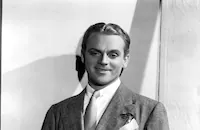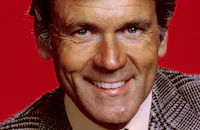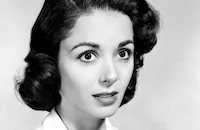Shake Hands with the Devil

Brief Synopsis
Cast & Crew
Michael Anderson
James Cagney
Don Murray
Dana Wynter
Glynis Johns
Michael Redgrave
Film Details
Technical Specs

Synopsis
In 1921, young American medical student Kerry O'Shea, whose Irish father was killed in an uprising against the British, comes to Dublin, and soon helps weapons smuggler Eileen O'Leary hide from the "Black and Tans," an armed force sent by Britain to surpress the Irish rebellion, Kerry tells her that although his heart is with the cause, he does not believe that "violence ever solved anything," and later he remarks to his nationalistic roommate, Paddy Nolan, that the rebellion is "your war." As the two friends leave a pub one evening, Kerry tries to help a terrorist who has been shot by a Black and Tan soldier. While dragging Kerry out of danger, Paddy is also shot, whereupon Kerry takes him to the home of a rebel sympathizer. There he learns that one of his professors, respected surgeon Sean Lenihan, is "the Commandant," the second-in-command of the rebel army. Despite Lenihan's best efforts, Paddy dies, and Kerry, having dropped a textbook inscribed with his name at the scene of the shootout, finds himself a wanted man. Lenihan takes him to "headquarters," where he meets "the General," who knew his father. Kerry is then taken to a small farm overlooking the ocean, to await the boat that will take him out of the country. There Kerry is introduced to Chris Noonan, a gentle poet who writes in Gaelic; Kitty Brady, a feisty barmaid who offers her own brand of comfort to the men, despite Lenihan's orders that she stay away; and Terence O'Brien, a swaggering thug who accuses Kerry of cowardice for not committing himself to the Irish cause. He also briefly meets the charming Lady Fitzhugh, an elderly rebel sympathizer who plans to smuggle an injured Irish terrorist named Liam O'Sullivan to safety. The plan goes awry, and Lady Fitzhugh is arrested just outside a pub near rebel headquarters. When O'Brien's gun falls to the floor, the Black and Tans assume it belongs to Kerry, and he is dragged from the pub and imprisoned. Kerry is tortured by the Black and Tans, and by the time Lenihan and the others rescue him, he is ready to join the rebellion. During his recovery, Kerry deepens his friendship with Noonan and romances Kitty, who willingly accepts his attentions. When it is learned that Lady Fitzhugh has been on a hunger strike since her arrest, Lenihan suggests that they take a hostage who may be used to effect an exchange. Kerry assists in the kidnapping of Jennifer Curtis, the widowed daughter of military adviser Sir Arnold Fielding, but soon after her imprisonment in a nearby lighthouse, he finds himself falling in love with her. Lenihan reminds Kerry that there is no room for pity and mercy in their war, whereupon Kerry replies that no war is worth winning if those human qualities are forgotten. The discovery by the British of Lenihan's involvement in the kidnapping forces the Commandant underground, and when he meets with the General, he learns that British officials are considering a treaty that would guarantee dominion status for Ireland. Horrified that the General would approve of such a compromise, Lenihan swears to fight until all of Ireland is declared a fully independent republic. Later, Lenihan and the other men meet at the lighthouse to discuss their plan to go to Dublin, where they can ambush and kill Col. Smithson of the Black and Tans. Kitty's presence infuriates Lenihan, and he orders her into the back room with Jennifer. Later, Kitty sneaks out to the beach for a swim in the nude, and when she realizes Lenihan has been watching her, she dares him to touch her. Burning with hatred, Lenihan orders her to leave. Back at her pub, when Kitty discovers that the Black and Tans are looking for her, Donovan, her employer, gives her enough money to book passage to England. Meanwhile, Kerry, aware that the coming morning's ambush is fraught with danger, bids farewell to Jennifer, who by now returns his love. At dawn, the men take their places on the dock, ready to attack Col. Smithson's approaching vehicle. Meanwhile, as Kitty is about to board a vessel to Liverpool, she is detained by Black and Tans. Because of her surprise at seeing O'Brien on the dock, the guards become suspicious and chase him. A gun battle begins, during which Lenihan, assuming Kitty has betrayed them, ignores her pleas and shoots her repeatedly. Seeing this, Kerry, horrified at Lenihan's brutality, goes to the Dublin headquarters and hears the General announce that the proposed treaty has been approved, and that he is on his way to London. Following his departure, however, the remaining rebels learn that Lady Fitzhugh has starved to death. When Lenihan returns to the lighthouse, he hands Jennifer a bible and leads her to the shore, where he plans to carry out an execution of revenge. Kerry pursues them, reminding Lenihan of the treaty and shouting that the Commandant now kills solely for the sake of killing. As Lenihan aims at Jennifer, Kerry cries, "I'm not going to fight your war!" and shoots him. Following Lenihan's death, Kerry looks with pain at his gun and flings it into the sea.

Director

Michael Anderson
Cast

James Cagney

Don Murray

Dana Wynter

Glynis Johns

Michael Redgrave
Sybil Thorndike

Cyril Cusack
Marianne Benet
John Breslin
Harry Brogan
Robert Brown
Lewis Casson
Christopher Casson
John Cairney
Harry Corbett
Eileen Crowe
Allan Cuthbertson
Donal Donnelly
Wilfred Downing
Eithne Dunne
Paul Farrell

Richard Harris

William Hartnell
John Le Mesurier
Niall Macginnis
Patrick Mcalinney
Ray Mcanally
Clive Morton

Noel Purcell
Peter Reynolds
Christopher Rhodes
Ronald Walsh
Alan White
Crew
William Alwyn
Michael Anderson
Eric Besche
L. B. Bulkeley
Rusty Coppleman
Irene Gilbert
George Glass
Ivan Goff
Steve Grogan
Erwin Hillier
Bill Kirby
Robert Lennard
Josie Macavin
Angela Martelli
Muir Mathieson
John Mccorry
Lt. Col. William O'kelly, Irish Defense Force
Gordon Pilkington
Cliff Richardson
Ben Roberts
Walter Seltzer
Sinfonia Of London
J. B. Smith
Roy Sturgess
Chris Sutton
Tony Szforzini
Marian Thompson
Joan White
Roy Whybrow

Videos
Movie Clip



Hosted Intro
Film Details
Technical Specs

Articles
Shake Hands with the Devil - Shake Hands With the Devil
Cagney plays Sean Lenihan, a professor at Dublin's Royal College of Surgeons who also happens to moonlight as a soldier in the IRA. Set in 1921, the story follows the ongoing battle between the IRA and British Black and Tan forces. Lenihan attempts to win his students (including one Irish-American played by Don Murray) over to the IRA's side, but his belief in violence as a solution is a tough sell. One student, however, will have a change of heart. And Lenihan will stand by his ideals until the very end, which is just as dark as one might expect, given the set-up.
The reviews were split on Shake Hands with the Devil. Several critics hailed Cagney's volcanic performance, and made special mention of Erwin Hillier's gorgeous cinematography. Others, though, felt that the wavering Irish accents of several of Cagney's co-stars distracted from the proceedings. But that's quibbling. Although the story may be unwieldy at times, this is one of the strongest roles of Cagney's latter-day career, and, rather than trying to act like a younger man, he wisely uses his advancing age to imbue his character with a little more depth. You can see that this somewhat misguided man has been through more than he cares to reveal, and Cagney lends him a forceful dignity.
When Cagney showed up in Ireland to begin filming the picture, he was embarrassed that the locals made such a big deal out of his presence. As far as they were concerned, Cagney was one of their own...never mind that he grew up in the Yorkville section of Manhattan. "Twenty years ago, I might have rated the big-star treatment," Cagney said, "but not now." True to form, he tried to undermine expectations by padding around the set in a pair of beat-up slippers. It was noted by some, however, that the slippers cost in the ballpark of $100 - a pretty steep sum for casual footwear.
Aware that he was starting to put on a few pounds, Cagney attempted to get closer to fighting shape before the cameras rolled. But he did so with his usual eye toward self-deprecation. On one memorable occasion, he held a press conference while an assistant pounded out tunes - including Yankee Doodle Dandy - on an upright piano. Cagney danced the entire time he answered questions, explaining to reporters that he was eight pounds overweight and could think of no more enjoyable way to lose them. "People get the idea," he said while puffing along, "that all film actors have to do is walk on a set, do as they are told, and collect a sum of money. It's not so. It's a job of work like any other job, you gotta be ready. I knew a guy who didn't take exercise between pictures. He had to run in one film. Took his heart by surprise. Went 'phhpht.'"
Producer/Director: Michael Anderson
Screenplay: Ivan Goff, Ben Roberts, Marian Thompson (based on the novel by Rearden Conner)
Cinematography: Erwin Hillier
Editor: Gordon Pilkington
Music: William Alwyn
Production Design: Tom Morahan
Set Design: Josie MacAvin
Costume Design: Irene Gilbert
Principal Cast: James Cagney (Sean Lenihan), Don Murray (Kerry O'Shea), Dana Wynter (Jennifer Curtis), Glynis Johns (Kitty Brady), Michael Redgrave (The General), Sybil Thorndike (Lady Fitzhugh), Marianne Benet (Mary Madigan), John Breslin (McGrath), Harry Brogan (Cassidy).
BW-112m. Closed captioning.
by Paul Tatara

Shake Hands with the Devil - Shake Hands With the Devil
Richard Harris, 1930-2002 - TCM Remembers Richard Harris
Harris was born October 1, 1930, in Limerick, Ireland, one of nine children born to farmer Ivan Harris and his wife, Mildred Harty. He was a noted rugby player as a youth, but shortly after his move to London in the mid-50s, Harris studied classical acting at the London Academy of Music and Dramatic Art. After a few years of stage experience, he made his screen debut in Alive and Kicking (1958) and quickly developed a reputation as a talented young actor. His film career became increasingly impressive with such strong supporting turns in Shake Hands with the Devil (1959), The Guns of Navarone (1961) and Mutiny on the Bounty (1962).
Yet it wasn't until 1963 that Harris became an unlikely star after thrilling movie viewers and critics with his electrifying performance in This Sporting Life. His portrayal of a bitter young coal miner who becomes a professional rugby star marked the arrival of a major international talent and won him the Best Actor award at Cannes and an Oscar nomination.
Strangely enough, Harris' next projects were multimillion dollar epics and he went largely unnoticed amid the all-star casts; he had a small role as Cain in John Huston's production of The Bible (1966) and in Hawaii (1966) he played a sea captain who falls in love with a married woman (Julie Andrews). He also tried his hand at a mod spy comedy opposite Doris Day - Caprice (1967). A much better role for him was playing King Arthur in the film version of the Broadway hit Camelot (1967). The movie was not well received critically, but Harris' singing skills proved to be a surprise; not only did he win a Golden Globe for his performance, but the film's soundtrack album proved to be a bigger commercial hit than the film itself. Even more surprising was his unexpected success the following year with the pop hit "MacArthur Park" - that kitsch cornerstone of lounge karaoke. The song just missed topping the Billboard singles chart in the "Summer of 1968;" It was topped by Herb Albert's "This Guy's In Love with You."
The '70s proved to be a mixed bag for Harris. He scored a huge commercial hit with his best-known film of that decade, A Man Called Horse (1970). It became a cult Western and featured him as an English aristocrat captured, tortured and eventually adopted by Sioux Indians. He also showed some promise behind the camera, co-writing the screenplay for the psychological thriller The Lady in the Car With Glasses and a Gun (1970) and directing (as well as starring) in The Hero (1972), a drama about an aging soccer star. But the quality of films in which Harris appeared declined as the decade progressed: Orca (1977) - a terrible Jaws rip-off, The Wild Geese(1978), and worst of all, Tarzan, the Ape Man (1981), in which he had a thankless role as Bo Derek's explorer father.
Based on those films and his general inactivity in the '80s, Harris' comeback performance in The Field (1990) was a wonderful surprise. In that film he played a man who has nurtured a field into a prized piece of real estate only to lose his sanity as the property is taken from him; the role earned him a deserved Oscar nomination and showed that he was still a vital screen presence. Harris took full advantage of this new spurt in his career by committing himself to many fine character roles: the cool, refined gunslinger in Unforgiven(1992), his intense portrayal of a father mourning the death of his son in Cry the Beloved Country (1995), the resident villain of Smilla's Sense of Snow (1997), and as the Roman emperor Marcus Aurelius in the epic Gladiator (2000).
Yet Harris will probably be best remembered by current audiences for his portrayal of Dumbledore, the benevolent and wily head of Hogwarts School in Harry Potter and the Sorcerer's Stone (2001) and Harry Potter and the Chamber of Secrets (2002) which will be released nationwide in just three weeks. Harris is survived by his three sons, Jared, Jamie (both actors) and the director Damian Harris.
by Michael T. Toole
Richard Harris, 1930-2002 - TCM Remembers Richard Harris
Quotes
Trivia
Notes
The working title of this film was The Raging Men. Although most contemporary sources list the film's running time as 110 minutes, the Daily Variety and Variety reviews list the running time as 104 minutes at a preview showing, and the Hollywood Reporter review gives a running time of 101 minutes. Several reviewers noted that the title was taken from an Irish proverb: "Those who shake hands with the devil often find they have trouble getting their hands back." The onscreen credits note that Michael Redgrave and Sybil Thorndike appear by "specail arrangement." According to an April 18, 1958 Los Angeles Times news item, Anthony Perkins was originally set to co-star in the film.
The picture was filmed at the Ardmore Studios in Bray, Ireland, and as stated in the credits, "on actual Irish locations," including the streets of Dublin. Although some contemporary sources state that Shake Hands with the Devil was the first American picture to be filmed entirely in Ireland, The Quiet Man was shot on location in Ireland in 1951. Shake Hands with the Devil was the first American film shot at Ardmore Studios, however, and was the first production of both Troy Films, which was Michael Anderson's production company, and Pennebaker, Inc., which was founded by Marlon Brando and his father, Marlon Brando, Sr., in 1955. Producers George Glass and Walter Seltzer, who were also partners in Pennebaker, were former press agents who made their producing debut with this picture.
As noted by studio publicity, the film marked the screen debut of actress Marianne Benet. Don Murray and Dana Wynter were borrowed from Twentieth Century-Fox for the production. A Hollywood Reporter casting note indicates that Maureen Halligan was to be appear in the film, but her appearance in the released picture has not been confirmed. According to a New York Times article, Lt. Col. William O'Kelly, the picture's special military adviser, was formerly a member of the Irish Republican Army.
The film depicts a period of the Irish "troubles," during which the "Black and Tans," consisting of former soldiers recruited by the British government, attempted to quell the Irish nationalist rebellion in 1920. Feared for their brutal methods, the Black and Tans were disbanded with the creation of the Irish Free State by the treaty of December 6, 1921. Although the film does not specify which part of Ireland was subject to the treaty, only the southern counties gained dominion status and became the country of Eire. Northern Ireland remains British territory. According to an July 8, 1959 Hollywood Reporter news item, Shake Hands with the Devil was banned from exhibition in Northern Ireland, where officials feared that the film would incite riots due to its subject matter. The ban was lifted in late August 1959, however, according to a Hollywood Reporter news item.

Miscellaneous Notes
Released in United States Winter January 1, 1959
Released in United States Winter January 1, 1959















